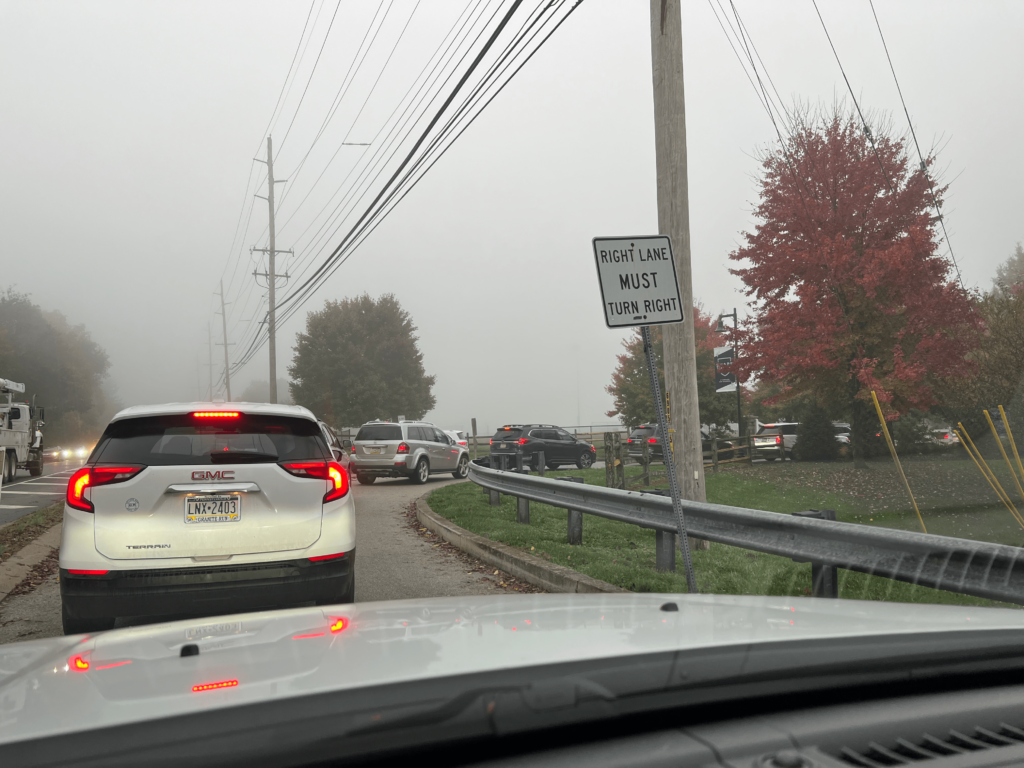Rohan Dalal ‘25
Since the start of the school year, EA has received complaints from teachers, students, and parents about traffic impeding their arrival to campus. As a result, the administration is pursuing efforts to reduce such traffic in the circle that feeds into the main entrance of campus.

Photo courtesy of Gianna Trala ’23
Head of Upper School Michael Letts attributes the increase in traffic to higher enrollment in the Lower School. “I think our numbers in the Lower School grew quite a bit over COVID, so I think a lot of this is that we have a much higher enrollment over the last two years in the Lower School than previously,” he explains.
In addition to more student enrollment, Director of Facilities Joseph Shanahan also believes that the COVID-19 pandemic has contributed to the increased traffic. He adds, “We definitely saw a change during COVID. I think we were getting less bus riders, and more people that wanted to drive in their own cars.”
Students are struggling to arrive at school on time, and many have had to adjust their schedules to avoid lateness due to EA’s new detention policy. Coleman Peskin ’24 says, “I’ve heard a lot of complaints about people being late to school because of traffic in the circle and it getting clogged in the student lot.” Connor Marciano ’25 adds that he “had to change [his] schedule” due to the increased traffic.
As a short-term solution, Letts is considering a later start time for the Upper School. He wonders, “Would it help if you [students] only had to be here by 8:15 to be in homeroom by 8:20, extending that window of drop-offs, [and if] the Lower School would still have to be here by 8:00, does that make life a little bit easier?” In terms of the schedule for the school day, Letts explains, “[EA] wouldn’t adjust the day. It’s just kind of shaving a few minutes off each block,” but he also acknowledges the plan’s drawbacks, commenting, “There’s certainly concerns around losing class time. If you take two or three minutes off of each academic block each day, over the course of the academic year, that adds up.”
Some members of the EA community support Letts’ idea. Ashley Kim ’23 says, “I love the idea of a later start time. Driving in at the same time as Lower School and Middle School, there’s typically an extra 20 minute wait at the traffic circle, which is 20 minutes that could be better spent sleeping or studying.”
In agreement with Kim, Charles Yespelkis, Upper School Math teacher, states, “You definitely notice the difference in traffic on days when we do or don’t have Lower School or Middle School here. Even just being 15 minutes earlier on those days makes it that much easier to get through the circle, so staggering [the start times] a little bit would make a difference for everybody getting to school.”
Letts’ idea still needs to be formally proposed before it is eligible for approval from Greville Haslam Head of School Dr. T.J. Locke. Although Locke supposes that “older students would benefit from a later start,” he thinks that the idea may have some drawbacks. “The logistics are complicated, and we have to be careful of creating new problems by fixing others. On most days, the traffic has completely died down just after 8:00 am, so it is important we do not overreact,” he cautions.
EA is also considering a long-term project regarding the widening of the roads across campus. Shanahan comments, “There are plans to widen Bishop White Drive and reconfigure the Middle School Circle to elongate it and give a bigger drop-off area. We are currently in the permitting process.”
However, the process from proposal to construction is long. Letts states, “[Making the roads wider] would take a lot of work with the township, whether we can get the approvals, whether we can get permission. That’s not an easy thing to do.”
Regarding the timeline of this project, Shanahan explains, “[I am] targeting the summer of 2024 to do this work [because] it’s not the type of work that we can do over the course of a school year.” He believes, “If we widen our roadways, [I will be] very interested to see what effect that has. Hopefully, that makes a significant improvement over traffic on campus.”